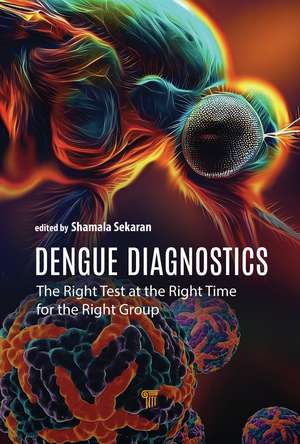Dengue Diagnostics: The Right Test at the Right Time for the Right Group
Editat de Shamala Devi Sekaranen Limba Engleză Hardback – 6 feb 2024
Preț: 979.22 lei
Preț vechi: 1030.75 lei
-5% Nou
Puncte Express: 1469
Preț estimativ în valută:
187.40€ • 194.92$ • 154.71£
187.40€ • 194.92$ • 154.71£
Carte tipărită la comandă
Livrare economică 14-28 aprilie
Preluare comenzi: 021 569.72.76
Specificații
ISBN-13: 9789814968973
ISBN-10: 9814968978
Pagini: 116
Ilustrații: 7 Tables, black and white; 12 Illustrations, color
Dimensiuni: 152 x 229 x 8 mm
Greutate: 0.7 kg
Ediția:1
Editura: Jenny Stanford Publishing
Colecția Jenny Stanford Publishing
ISBN-10: 9814968978
Pagini: 116
Ilustrații: 7 Tables, black and white; 12 Illustrations, color
Dimensiuni: 152 x 229 x 8 mm
Greutate: 0.7 kg
Ediția:1
Editura: Jenny Stanford Publishing
Colecția Jenny Stanford Publishing
Public țintă
Academic and PostgraduateCuprins
1. Introduction to Dengue and Issues with Current Diagnostics 2. Traditional and Current Diagnostics 3. Newer Diagnostics for Dengue Disease 4. Search of Newer Markers for Dengue Disease 5. Research and Recommendations
Notă biografică
Shamala Devi Sekaran is a professor in the Faculty of Applied Sciences at UCSI University Kuala Lumpur Campus, Malaysia. She teaches immunology and microbiology to undergraduates and postgraduates of medical, dental, and biomedical sciences. She obtained her PhD in 1986 on cell-mediated immune responses to dengue in mice. She is a fellow of the Academy of Sciences, Malaysia, since 2017 and fellow of the Royal Society of Pathologists, London, since 2019. Administratively, she was the director of the WHO collaborating center from 2003 to 2007; a member of the faculty committee for postgraduate degrees and viva voces, promotions, and counselling; coordinator for the MBBS, dental and biomedical courses; and head of the virology diagnostic laboratory. Her expertise is in research on infectious diseases, focusing on dengue and the development and evaluation of diagnostics, endothelial dysfunction mechanisms, and antivirals. She has received multiple awards for the kits developed, owns more than 20 patents (out of which 3 are commercialized), has published more than 250 research papers, and has an h-index of 44 with more than 6000 citations. Currently, she is investigating the effects of diabetes and obesity on severe dengue and attempting to develop serological assays to differentiate flaviviruses.
Descriere
This book deals with most of the methods that have been used or developed for diagnosing dengue. It addresses the timeline for the evolution of the virus in the body, the body’s response from the onset of fever, and the role of diagnostics as time progresses.
